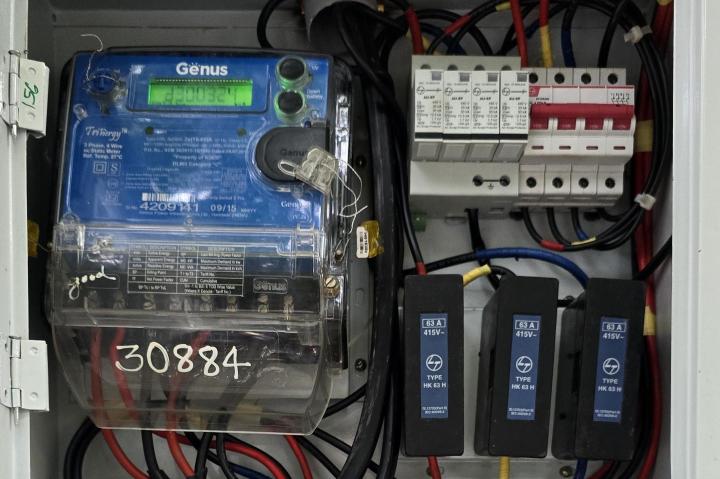News
Installing a Surge Protection Device (SPD) in my home EV charging setup
It is designed to protect circuits and associated facilities from damages caused by transient over-voltages & spikes.
BHPian sushanthys recently shared this with other enthusiasts:
Hi guys.
This is an update to my thread.
Now, I have taken an LT-X connection at my home for the sole purpose of EV Charging. The connection had been initiated in August 2024. I received the first bill last month (October 2024). The amount came out to be Rs.8351. This amount is for charging 2 EVs, both having covered around 5000 KM together in these 2 months. If I had 2 petrol cars, assuming a mileage of 15km/L and a petrol cost of Rs.100/L (Both values being highly optimistic), I would have ended up spending Rs.33,000 for fuel costs alone. My home connection is linked to a 5KW rooftop solar plant. My monthly home electricity bill comes to around Rs.200. So, it’s a win-win situation all around.

Now, BHPian EVFan wanted to see my charging setup. I had invited him home and he came in his blue Hyundai Kona (a very handsome car). We had a discussion about our cars & charging & lot of other EV-related stuff. I showed him my charging setup. He explained some practical aspects of the system to me & mentioned that it would be a good idea to install a Surge Protection Device (SPD). My LT-X connection did not have it but my solar setup had.

I was not aware of SPDs and researched the subject online. The following is a simplified version of what I learned about it.
What is an SPD?
An SPD is an electrical appliance designed to protect circuits and associated facilities from damages caused by transient over-voltages & spikes. Basically, it protects your circuit and the connected electrical appliances from an uncontrolled voltage surge.
SPDs detect voltage surges & divert excess power to the ground to prevent electrical devices from being damaged. An electrical power surge, in simple terms, is when there is a significant increase in voltage that exceeds the standard voltage flow. The duration may be only a few seconds, or even less than a second, but as a result, electrical equipment can be damaged or in rare cases, destroyed if an SPD is not fitted. Electric surges can be caused by lightning strikes, faulty wiring or electrical overloads. Without SPDs, these surges can damage or destroy electrical equipment, including EV Chargers.
Are there different types of SPD?
There are 3 types of SPDs.
- Type 1 (Class I SPD) is installed at the service entrance of an electrical system and designed to withstand high energy surges and protects the entire circuit from severe transient events. They are designed to be installed at the main electrical panel.
- Type 2 (Class II) SPD is typically installed downstream from Type 1 at distribution panels. It works in combination with Type 1 SPDs, protecting against residual surges and lower energy transients. They offer a second layer of defence, preventing surges from travelling further into the network.
- Type 3 (Class III) SPD is installed at the point of use and provides accurate and localized surge suppression against low-energy surges.
Why is SPD important for EV Charging Point Installations?
EV Charging systems are often more prone to power surges than other electrical systems. This is due mainly to the sophisticated electronics involved. Also, since EV Charging points generally tend to be situated outdoors, they are more sensitive to lightning & thunderstorms. Kerala, especially Kottayam tend to have plenty of these during our 6 months of monsoon season. Installing an SPD ensures that your system works safely & efficiently and helps prevent irreversible damage to your charging system.
If damage occurs from an electrical surge, the cost to replace or repair the damaged charging equipment is significantly higher than the cost of an SPD (though the SPD installation itself costs a decent amount of money). Although fail-safes are present and the chances are very low, your EV can also get damaged if a voltage surge occurs during charging. It’s better to be safe than sorry. It is worth getting an SPD installed in your EV charging circuit, for added peace of mind.
Is it mandatory to install an SPD for EV charging?
In India, according to the guidelines, Type 1 and Type 2 SPDs are mandatory for DC Fast chargers.
Whether it is necessary for Type 1 & Type 2 AC chargers, primarily used for home charging, I am not sure.
Why did I decide to install an SPD?
In February of this year, I had a problem with my MG ZS EV when it suddenly stopped charging. On connecting the charger, the vehicle would acknowledge charging but charging would not take place. I had charged the car with the 7.2 Kw charger 6 or 7 times consecutively, prior to the incident (generally, I use the 15A slow charging). I took it to the service centre. It took them 3 days to diagnose the problem. The EP2CCU had become faulty. They would not tell me the reason but hinted that it could have been due to a surge. The cost of the part was around Rs.84,000 but it was replaced for free, under warranty. The service guys asked me to call the EXICOM people (the 7.2 kW charger company) to come and check out the charger but they never turned up.
The problem never recurred and I use the same 7.2 kW charger regularly. But I did not want the situation to happen again. If the problem was due to a surge and if an SPD would avoid it, then it was better to install one. So decided to proceed with it.
I called my trusted electrician and discussed matters with him. He agreed to install the SPD.
As usual, he took some time to come for the work. He examined the setup and got the necessary equipment. The SPD was a 3- 3-phase one from L&T.


The first step was to do the earthing. He explained that for SPD earthing, you need a really deep pit and a 1.5 m long Galvanized Iron (GI) Pipe. The earthing should be at least 5m away from other earthing equipment and it should be in an open area as the soil should be moist for efficient surge dissipation.
He came in the afternoon and as I had some pending work, I was away. On returning home, I found him at the base of a large pit around 5-6 feet deep! The entire 1.5 m long pipe had to be buried upright inside the pit. He and his assistants had dug the pit manually, no mean feat!
After reaching the required depth, he hammered the pipe into the pit till it was secure. Then the pit was watered, to ensure enough moisture. Then he started filling up the pit. Periodically, he would sprinkle charcoal and salt liberally to ensure conductivity. And water the soil in between. As he reached the surface, an earthing compound was also added. Only soil was used to bury the final layer. Any rocks present were removed.




The soil was allowed to settle for one day. The rest of the SPD installation took around 2 hours. The thick earthing cable (6mm Copper) was properly fixed to the earthing pipe.



The SPD was accommodated in the main energy meter board itself (Type 1+2 SPD). The earthing was connected to the SPD. The Copper earthing cable should be routed through a 20mm PVC sleeve till the earthing pipe. The part of the earthing cable inside the meter board should be encased in insulation to avoid mishaps.

The job as usual was very tidy. The SPD cost was around Rs.11,000 (this is a 3-phase SPD; Single-phase SPD will cost much less). The cost of all the necessary equipment came to around 17k and the final charges including labour came to around Rs.21,000.

As you can see, the 3-phase SPD has 4 cartridges. The squares on top are currently black, but they will turn green once they start handling surges. Once the cartridges turn red, they no longer offer protection and will have to be replaced. The cartridges can be bought separately. Importantly, keep a watch periodically on the SPD so as to replace the cartridges once their lifespan is over. Also, the earthing area should be watered in dry seasons to keep the soil moist.
Now, in newer homes, SPDs will come as standard installation. You will not have to bother with all this rigmarole. But everyone may not get an SPD installed in view of the costs. In such cases, in older homes where SPD is not there or when you are getting a specific EV connection, make sure to have the SPD installed. And make sure to install it correctly with proper earthing. Do not do it as a DIY project. Get it done by a qualified professional.
That’s it, folks.
EVs are becoming more & more common and owners are very much aware of home charging. Do remember that you are charging a powerful electric product and that your system should be capable of handling the load. Also, your EV and you should not suffer because of the lacunae in your charging infrastructure. Obey the basics and properly secure the installation. Do it well so that you don’t have to worry about it in future.

Check out BHPian comments for more insights and information.













.jpeg)





